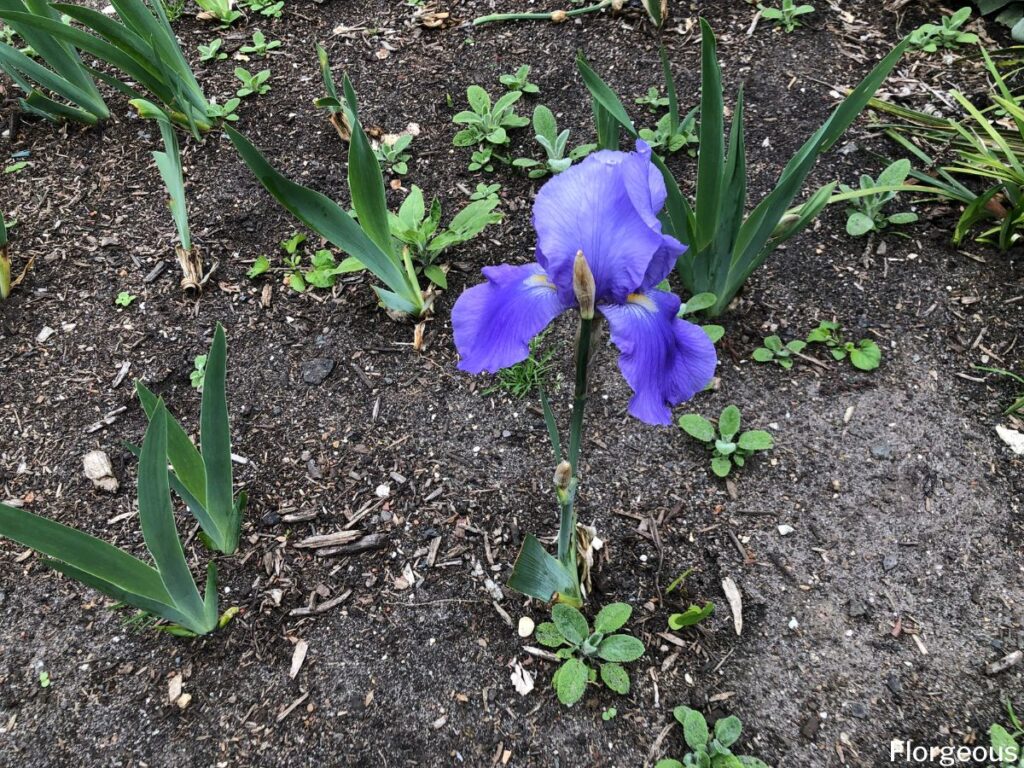Are you wondering what to plant in front of irises? In this guide, we take a look at the best iris companion plants to add to your garden.
Irises (Iridaceae) are popular garden plants because they create a very unique bloom and they are very easy to grow.
These gorgeous flowering plants can make your garden look much more appealing and vibrant during late spring and early summer.
Most gardeners prefer to go beyond simply planting irises alone, instead selecting companion plants to enhance the beauty of garden beds even more. But with so many options available, it can be difficult to decide on the best bearded iris companion plants.
In this guide, we are going to take a closer look at some of the top plant species for companion planting.
Irises and their Growing Requirements
There are over 260 different species of the common iris and they can greatly vary in color.
The most common iris varieties are violet-colored irises like Blue Betty (I. ensata), and the I. Germanica, and the I. Unguicularis. But you can find lots of other colors like black, white, yellow, pink, and even multi-colored varieties.
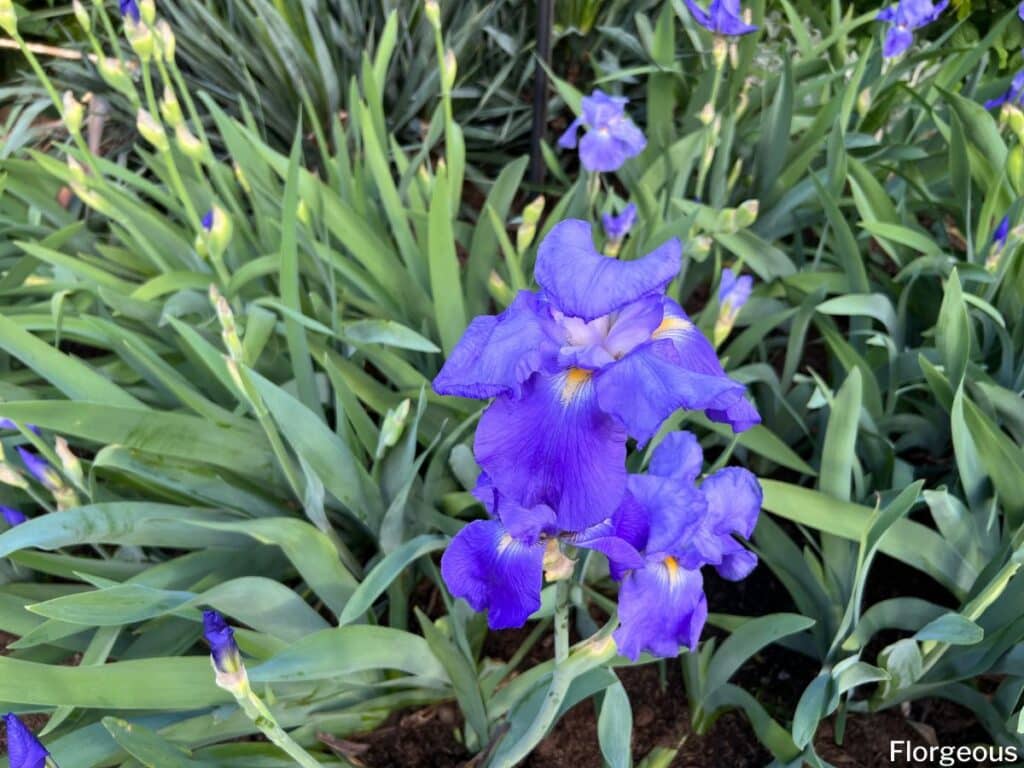
Bearded irises typically grow 2 – 3 feet tall while dwarf irises only reach a height of 4 – 9 inches. Most iris varieties bloom from late spring to early summer, but some, like Japanese iris or Siberian iris, offer a delightful surprise by blooming twice a year in spring and fall.
The bearded iris is an evergreen plant and stays beautifully green throughout the year, especially if they are grown in warmer climates. But they will only show bold colors during the blooming season.
When irises are not in bloom they can resemble tall ornamental grass. Pairing your iris growths with other perennials can help you create a garden that looks interesting during other seasons.
For successful companion planting, you need to identify plants that have the same growing requirements as irises.
Here is a quick list of the basic growing conditions that are needed for irises.
Sunlight Requirement for Irises
Irises need to be planted in full sun or light shade and in good air circulation. If planted in partial shade, the flowers might fail to bloom and irises won’t develop well in shaded areas.
Soil and Water Requirements for Irises
The soil and watering needs can differ for iris species. Bearded irises are quite drought-tolerant and need to be planted in well-drained soil. If these irises get too much water, their root systems can start to rot.
Water irises, on the other hand, can be grown in soggy areas alongside shallow waters or even inside a shallow pond. They need a lot of water and their roots should stay wet.
What to Plant With Bearded Irises
Once you understand how to grow irises, you can start seeking good companion plants that can survive under these same conditions.
Here is a quick look at what to plant with iris:
Peonies
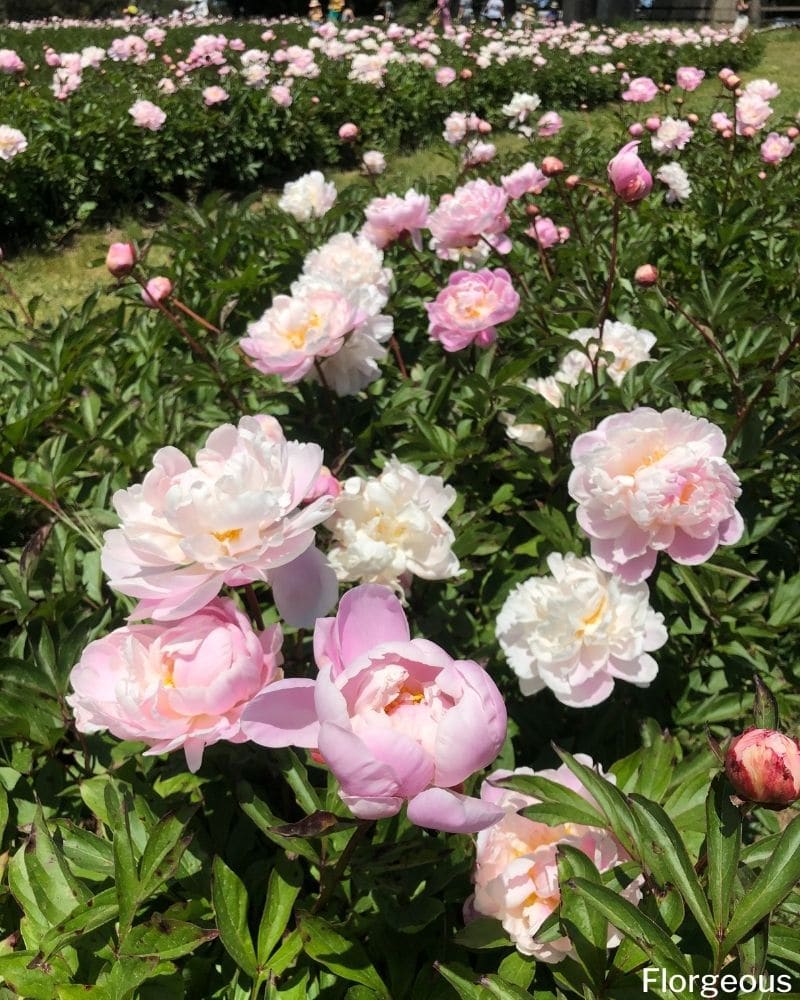
The Peony (Paeonia) is a great plant to pair with iris flowers because they also bloom late spring to early summer and can create a more vibrant look during the flowering season.
Along with their beautiful blooms, these perennials can grow 1 – 3 feet tall. With this height, it is usually recommended to plant peonies in bare spots alongside irises.
There are 30 species of peonies, and their colors include white, pink, and yellow. To create a harmonious display, choose companion plants that complement the peony’s blooms.
Gardeners recommend choosing a different color of peonies than your bearded iris so the peonies won’t overpower your irises. This is especially important since peonies do have rather large blooms and these flowers can be very vibrant.
Peonies are not too fussy about soil conditions but need well-draining soil. They also prefer a sunny location which makes them ideal for your iris flower bed.
With peonies and irises growing together, your perennial garden is sure to look great and you will have lots of vibrant blooms to harvest for indoor flower arrangements.
Forsythia
The Forsythia (Forsythia) is known for its vibrant yellow blooms that sprout all over these brushes during early spring.
When not in bloom, these plants can look a bit simple with their small leaves and grey-brown bark. During the blooming season, the entire shrub will be covered in small yellow flowers.
This is a great companion plant to grow behind your bearded iris garden bed because it supports the growth of bearded irises and can create a stark contrasting backdrop. It is also best to add these plants behind irises because the shrubs can reach a height of 1 to 3 meters and will overpower any companion plants behind them.
Since the forsythia blooms during early spring, we recommend you look out for bearded iris varieties that have a similar bloom season. With a gorgeous yellow backdrop, the flower heads of your irises are bound to stand out excessively. Any type of iris variety will however look great against the yellow backdrop because the spiky leaves of iris plants resemble ornamental grass and will look stunning against a yellow backdrop even without any iris flowerheads.
Forsythia bushes are relatively drought tolerant but prefer moist soil. As with irises, they also prefer full sun.
See more: What to plant with forsythia
Lupine
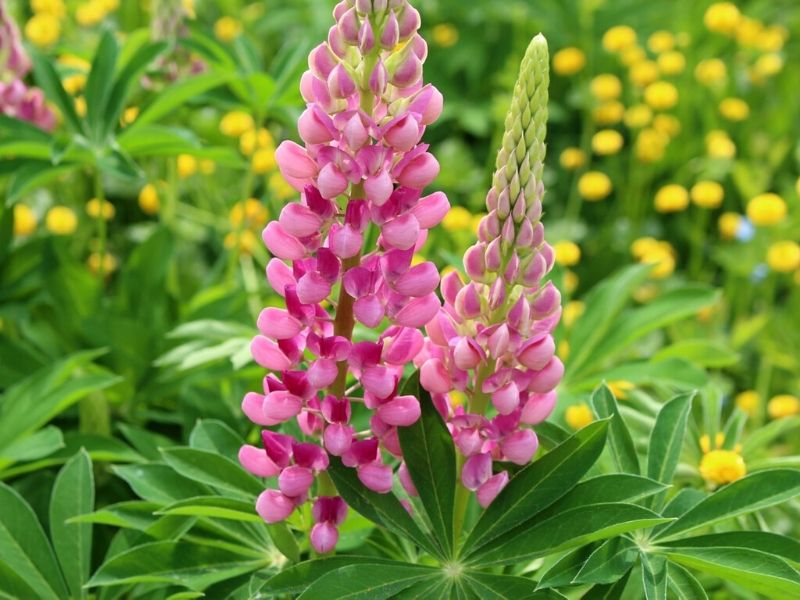
The Lupine plant (Lupinus), also referred to as lupin or bluebonnets, is one of the best companion plants to grow alongside bearded irises or Siberian irises. These plants are great for filling blank spots and for achieving more flowers in the same garden bed.
There are over 199 species of lupin flower in North and South America and, while most of these are purple and blue-toned, there are also different varieties in other vivid colors like pink, yellow, orange, white, red, and even multi-colored varieties.
It is best to pair bluebonnets inside your garden bed instead of in front of an iris growth because they reach a height of 1 – 5 foot tall.
These perennials have soft green or grey-green leaves that can create more contrast in your iris flower bed. Lupin flowers are pea-shaped and they are produced along an erect spike.
These plants are typically planted in late spring or early fall and typically bloom during late spring to mid-summer. Some gardeners also plant their lupine plants a bit later so they can produce flowers at a later time. If you plant iris and lupine at the usual time, they should bloom at the same time. But if you plant lupine later, it can help you maintain a more vibrant garden for longer.
These low-maintenance plants require similar growing conditions as irises and flourish in full sun but can also grow in light shade. They also require well-drained soil to avoid diseases or rotting in the root system.
Phlox Flowers
The phlox flowers (Phlox) are other ideal companion plants that you can grow inside of your garden bed along with tall bearded irises. There are 67 species of phlox flower plants and their blooms can include hues like pale blue, violet, pink, bright red, or even white.
Phloxes are easy plants that go well with iris. They are great for adding more color to your garden because they have a six-week blooming duration with their best blooms in summer. Taller plants can reach a height of 2 – 3 feet and are ideal for filling blank areas in your garden.
Because the flowers of this foilage are so vivid, it is always best to pair them with a contrasting iris variety. For example, if you have purple irises, then it is usually best to grow white phlox plants so these flowers won’t overpower your irises.
These garden plants require good drainage and full sun. They can tolerate light shade but won’t flower as vibrantly if they don’t get enough sunshine.
Dianthus
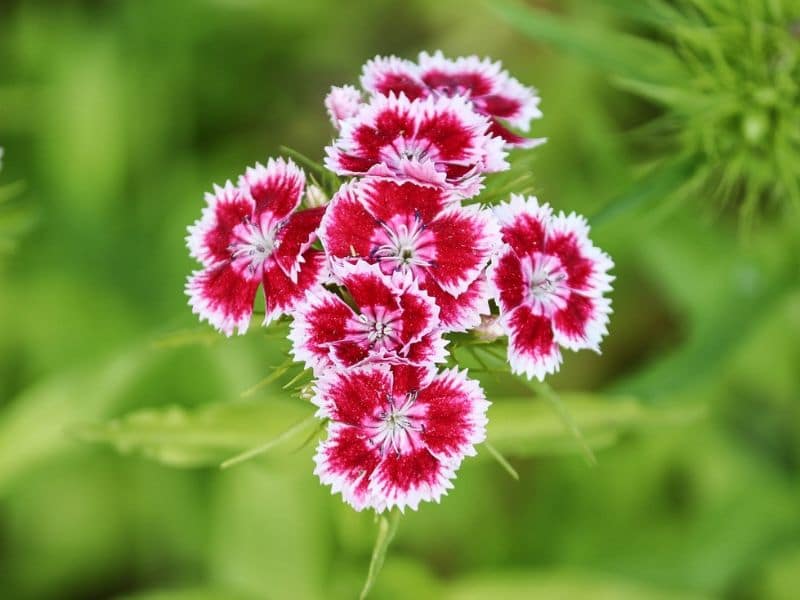
Dianthus flowers (Dianthus spp.), often referred to as pinks, are a great option if you want something to grow in front of your iris perennials because they will reach a maximum height of 6 – 18 inches. This low height is ideal for creating a border in front of, or around your iris foliage and won’t obscure your view of the flowers or the beautiful spiky leaves of the iris.
There are over 27,000 registered cultivars in the Diahntus genus and these plants can include annuals, biennials, and evergreen perennial varieties.
These vibrant plants boast an array of color combinations, typically featuring pink, white, and purple hues, often with charming bicolored petals. Their blooming period aligns perfectly with irises, typically gracing gardens with their colorful presence in spring to early summer.
The dianthus is a good companion plant for iris blooms because they require similar growing conditions. These plants flourish in direct sun but can grow in light shade and they will only develop properly if planted in soil that drains well.
Best Companion Plants for Water Irises
Water irises are ideal for moist planting conditions around a pond and some varieties can even grow inside shallow waters. There are not too many other perennial plants that will fare well in these moist conditions but you can find some companion plants to pair with water irises for a more dramatic look in or around a fish pond.
Here is a quick look at the best spring-blooming perennials to consider for water irises.
Water Lilies

Water lilies (Nymphaeaceae) are flowering plants that grow inside water bodies. There are about 70 species of waterlily and most prefer tropical climates. These plants produce large rounded leaves that drift on top of the water.
These plants might not bloom at the same time as your irises. Instead, they bloom from early summer to late fall and can help brighten up ponds when your irises fade.
Cattail
Cattail (Typha), also known as bulrush, reedmace, reed, or punks, can be a fantastic companion plant for bearded iris plantings, particularly those situated near water features. Their resemblance to ornamental grass, thanks to their long, slender leaves, creates a visually cohesive aesthetic. Additionally, cattails boast fascinating flower spikes adorned with unique, clustered blooms that resemble sausages strung along a stalk.
Cattails can grow 1 – 3 meters tall and can produce a very interesting backdrop for your water irises. Their flower heads open up in early fall but the leaves will offer lots of contrast throughout the year.
Pickerel Weed
The Pickerel weed (Pontederia cordata) is a great choice for adding vibrant blooms to your pond or water garden.
This aquatic plant thrives in both water and moist soil along the bank, showcasing large, heart-shaped leaves and captivating purple flowers displayed on spikes. While individual flowers on the spike may only last a day, the plant continuously produces new blooms throughout the summer, offering a colorful display for three seasons.
Benefits of Adding Companion Plants to an Iris Garden
Companion planting with irises offers many benefits, including creative landscaping ideas with irises. This is an ideal solution for anyone who loves irises but might find their gardens a bit too dull or who might want a formal setting throughout the year.
Let’s take a closer look at the main benefits of pairing irises with other plants.
Extend Your Garden’s Blooming Season
Irises typically only bloom from late spring to fall but the blooming season may vary for different iris varieties. Adding companion plants to your garden is a good way to extend the blooming time of your garden or to create a more vibrant-looking garden when the irises fade.
Create a Fuller Garden
Iris tubes don’t take up much space in a garden. You need to have a lot of iris growths to fill out a garden bed. Combining different plant species is a great way to fill out your garden or to eliminate blank areas in your garden.
More Beautiful Arrangements
Combining different flower species that complement one another is a great way to create a more beautiful garden. You can also harvest these flowers and create interesting flower arrangements indoors for vases.
More Food for Bees
Bees enjoy harvesting nectar from flowering plants like irises. But the iris plant doesn’t produce a whole lot of blooms on each plant. Adding other plants with more vigorous blooms can be a good way to produce more food for bee populations.
How do I arrange irises in my garden?
When you are busy planning your garden, it is usually best to place your plants from lowest to tallest.
Tall foliage should be positioned at the back behind irises in order to create a backdrop for your flowering plants. Irises can be placed in the middle section along with other plants of the same height so you can create a more vibrant bloom in your garden.
Position shorter foliage at the front of your irises to conceal some of the unsightly roots and dead leaves. Shorter plants can also be grown around irises to help accentuate your iris or to create more contrast between the iris growths and surrounding lawns.
Frequently Asked Questions
What flowers at the same time as irises?
Several flowers bloom at the same time as irises, including peonies, roses, alliums, and poppies. Planting these together can create a beautiful and harmonious garden display.
What is the best ground cover for iris beds?
The best ground cover for iris beds depends on the specific growing conditions and preferences of the gardener. Some options include creeping phlox, creeping thyme, sedum, or low-growing ornamental grasses. Choose a ground cover that complements the irises and provides weed suppression and soil erosion control.
Can lilies and irises grow together?
Yes, lilies and irises can grow together successfully in the garden. Both plants prefer similar growing conditions, including full sun and well-draining soil. Plant them in complementary colors and consider their height and bloom time to create a visually appealing garden display.
Final Thoughts
We hope that this guide helped you figure out what plant goes well with irises and made it easier to choose plants. There are many types of flowering plants and garden foliage that do tremendously well in the same growing conditions as irises and you can be very creative with your garden layout and design if you know what plants to combine.
If you want to learn more about irises or any of the other plants we mentioned on our list then we welcome you to have a look at some of our other guides.
See more: What does the iris flower represent?

